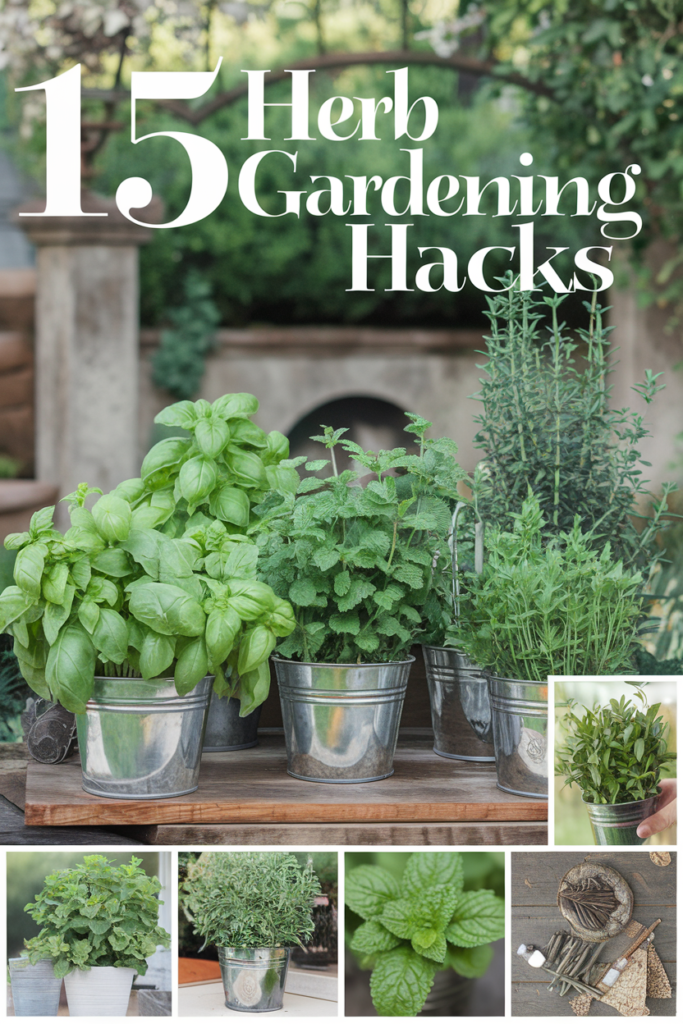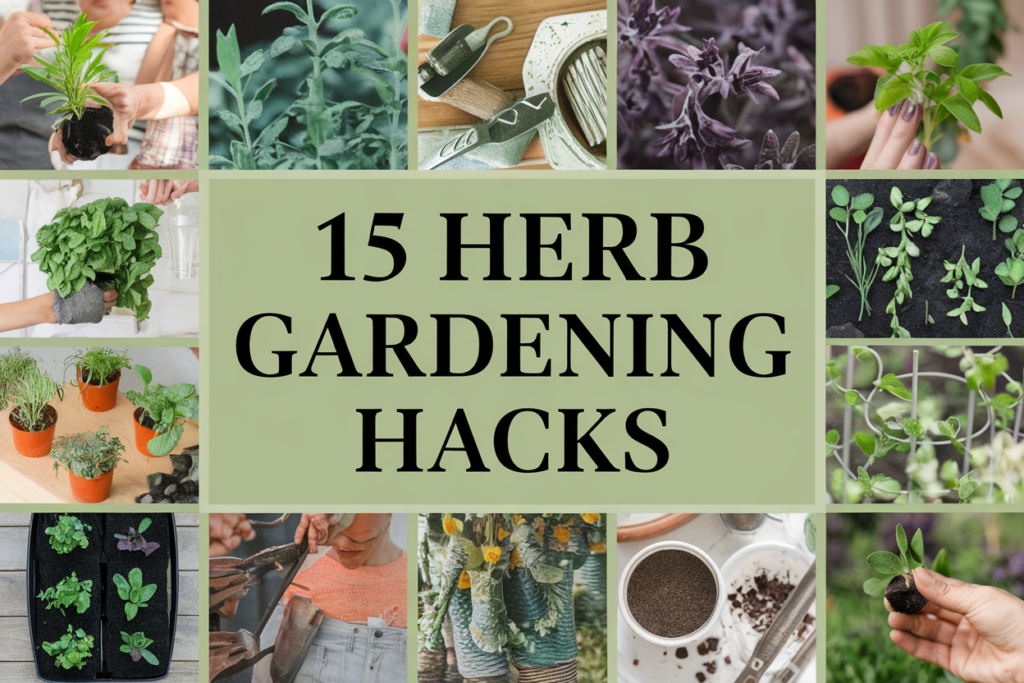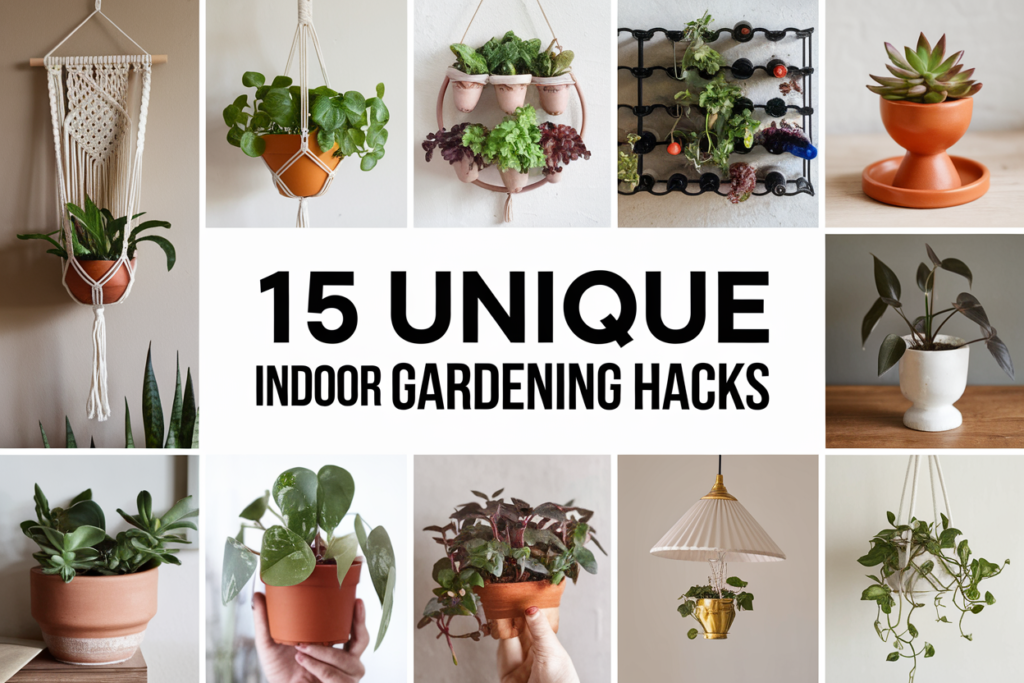Looking to add a splash of greenery to your home without the hassle? These 15 creative herb gardening hacks are simple and fun ways to grow your own herbs, making it easy to spice up your cooking or simply enjoy the beauty of fresh plants around you. Get inspired and discover how to turn your space into a herb haven!
Use Mason Jars To Grow Herbs On Windowsills For Easy Access.

Using mason jars to grow herbs is a fun and practical way to bring greenery into your kitchen. The image shows several mason jars filled with vibrant herbs, positioned on a sunny windowsill. This setup not only looks attractive but also makes it easy to grab fresh herbs whenever you need them.
Mason jars can be used to grow a variety of herbs such as basil, mint, and rosemary. They provide ample space for roots to grow and offer a clear view of the beautiful greenery inside. This simple method is perfect for those who enjoy cooking and want to have fresh herbs at their fingertips.
To get started, fill each jar with potting soil, and plant your herb seeds or small plants. Make sure to place the jars in a spot where they can receive adequate sunlight. Water them regularly, and soon you’ll have a mini herb garden right on your windowsill!
Regrow Kitchen Herbs Like Basil And Mint From Cuttings In Water.
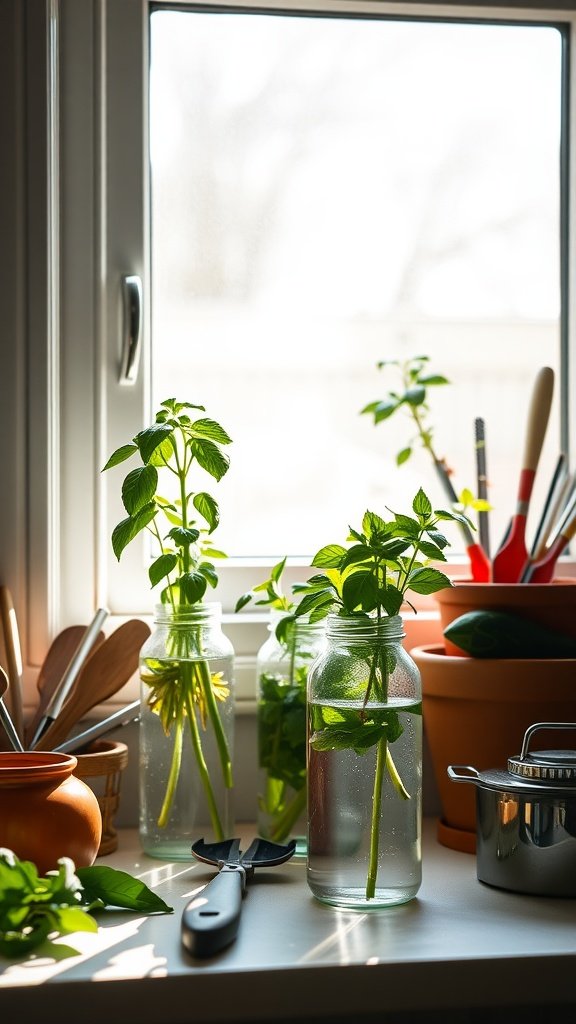
Regrowing kitchen herbs like basil and mint is a fun and rewarding project. In the image, we see fresh herbs placed in jars filled with water, soaking up the sunlight. This setup not only looks great but also serves a practical purpose.
To start, take cuttings from your herbs. Ensure they have a few leaves at the top. Place these cuttings in a glass jar filled with water, making sure the leaves are above the waterline. Set them by a sunny window. In a week or so, you’ll notice roots starting to form.
Once the roots are a few inches long, you can transfer your herbs to pots with soil. They will continue to thrive and bring freshness to your meals. This method is easy and perfect for those looking to grow their own herbs without much effort.
Place Herbs In A South-Facing Window For Optimal Sunlight.
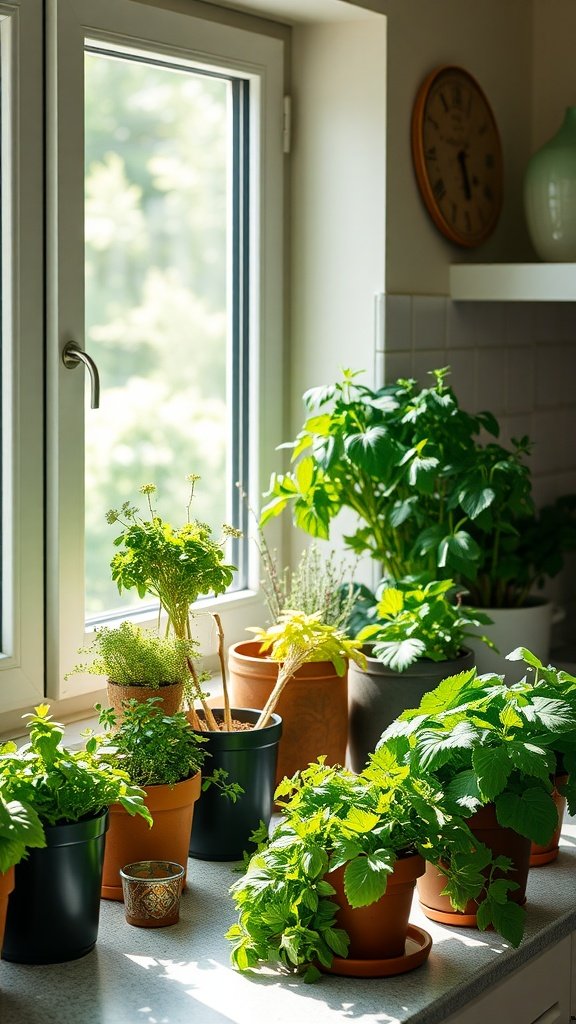
When growing herbs at home, positioning is key. A south-facing window provides the best natural light for your green friends. This spot generally gets the most sunlight throughout the day, which is essential for herbs to thrive.
In the image, you can see a variety of herbs basking in sunlight. The light pours in, creating a perfect environment for plants like basil, mint, and parsley. They look vibrant and lush, showing how much they love their sunny spot!
Keep in mind that herbs need about six hours of sunlight daily. You might want to rotate your pots occasionally to ensure all sides get equal light. This simple step can lead to healthier, more robust plants.
Don’t forget to monitor the temperature by the window as well. If it gets too hot or cold, your herbs may not do as well. Finding that sweet spot will help your kitchen garden flourish.
Use Coffee Grounds To Boost Soil Acidity For Herbs Like Rosemary.
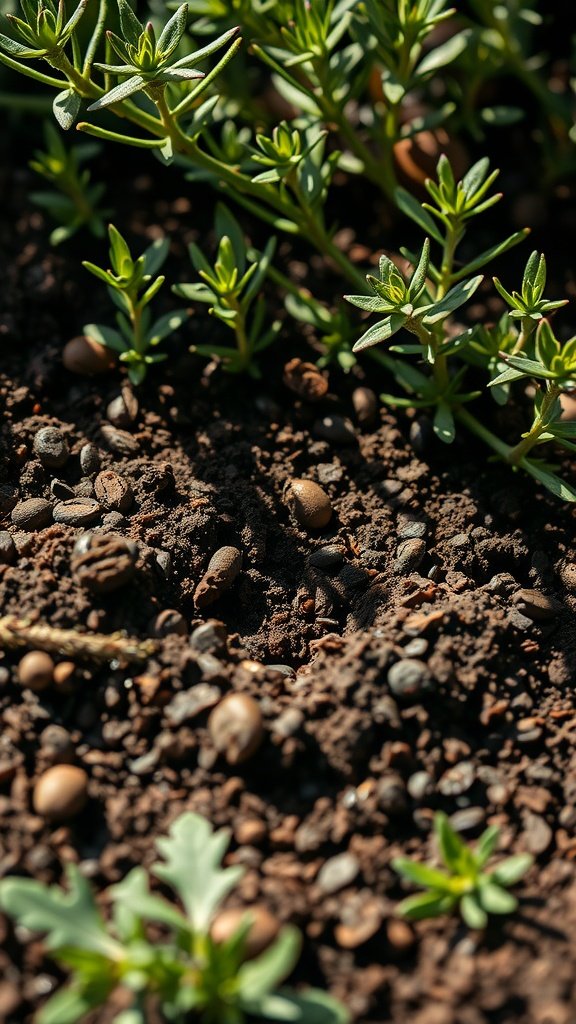
Coffee grounds are a fantastic, eco-friendly way to improve your herb garden’s soil. In the image, you can spot fresh, vibrant herb plants peeking through dark, nutrient-rich soil. This is a great reminder of how organic matter, like coffee grounds, can play a significant role in nurturing plants.
Rosemary and other herbs thrive in slightly acidic soil. Mixing coffee grounds into your garden can give them the boost they need. The grounds not only enhance the soil’s acidity but also add valuable nutrients. Plus, it’s an easy way to recycle your used coffee!
To use coffee grounds, simply sprinkle a thin layer over the soil and mix it in gently. Be careful not to overdo it, as too much can lead to issues. A little goes a long way in making sure your herbs get the right environment to flourish.
Create A Vertical Herb Garden With Wall-Mounted Planters.
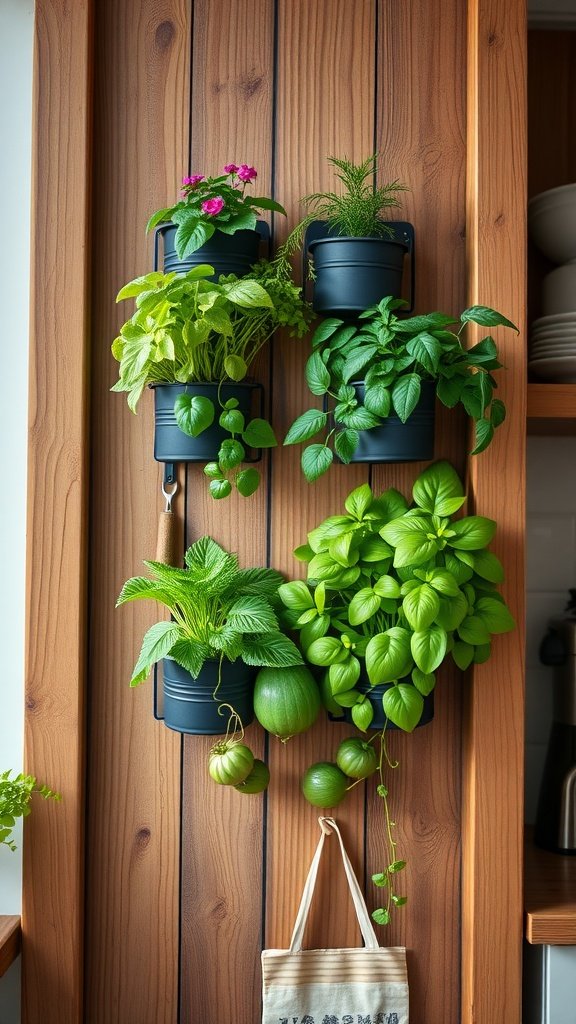
Transforming your kitchen or living space into a mini herb garden is easier than you might think. Wall-mounted planters are perfect for those who want to save space while keeping fresh herbs within reach. The image shows a stunning vertical garden, with various herbs thriving in sleek black pots against a warm wooden backdrop.
The vibrant greens and pops of color from the flowers create a lively atmosphere. This setup not only looks great but also maximizes your growing area. Imagine snipping fresh basil or mint right from the wall while cooking!
To get started, find a suitable wall space in your home. Choose herbs that you love to use regularly, like rosemary, thyme, or parsley. Make sure to select planters that allow for proper drainage. This will ensure your herbs grow healthy and strong.
The best part? Vertical gardens are low-maintenance and can enhance your kitchen’s aesthetic. Plus, they can inspire you to use fresh ingredients in your meals, making cooking even more enjoyable!
Start An Indoor Herb Garden Using Led Grow Lights For Year-Round Growth.

If you want fresh herbs year-round, consider starting an indoor herb garden with LED grow lights. The image shows a vibrant array of plants basking under bright lights. You can see various herbs like basil, mint, and maybe even some leafy greens. These lights provide the perfect spectrum for plant growth, ensuring your herbs thrive even in the cold months.
Using LED grow lights makes it easier to control the growing conditions. They produce low heat, which is ideal for maintaining a comfortable indoor environment. You can position them close to the plants without worrying about scorching leaves. Plus, they use less energy compared to traditional grow lights, making them a smart choice for your home.
Having an indoor herb garden is not just about fresh ingredients; it adds a touch of greenery to your space. Imagine snipping fresh herbs for your meals, knowing they were nurtured right in your kitchen. Whether you’re an experienced gardener or a beginner, using LED grow lights can make the process enjoyable and rewarding.
Add Sand Or Gravel To Potting Mix For Better Drainage In Herb Pots.

When it comes to growing herbs, the right potting mix is key. The image shows a hand adding sand or gravel to a pot filled with fresh potting soil. This simple action can make a huge difference for your herbs.
Good drainage helps prevent water from sitting at the bottom of the pot. This is important because many herbs, like basil and rosemary, prefer their roots to be dry rather than soggy. By adding sand or gravel, you create air pockets in the mix, allowing water to flow through easily.
Many gardeners recommend a ratio of about one part sand or gravel to three parts potting soil. This mix not only enhances drainage but also promotes healthier root growth. So, next time you’re potting your herbs, don’t forget this little hack for better drainage!
Use Kitchen Scraps Like Egg Shells To Fertilize Herbs Naturally.
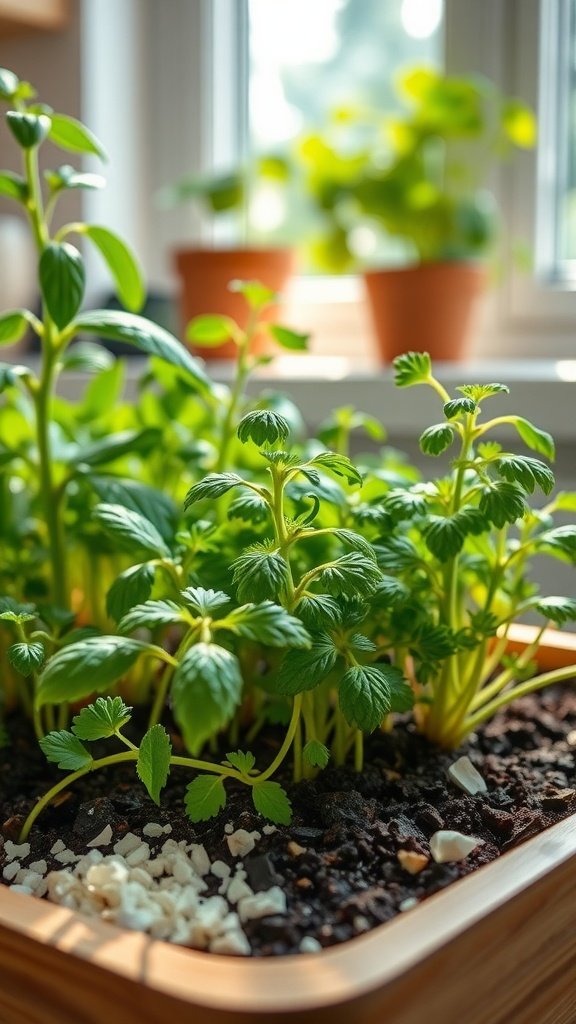
Using kitchen scraps is a smart way to nourish your herb garden. Eggshells, in particular, are a fantastic choice. They are rich in calcium and other nutrients that help your herbs thrive. Instead of tossing them in the trash, save those shells for a natural fertilizer.
The image shows a vibrant herb garden, full of healthy green leaves. This is exactly what you want to achieve. By crushing up eggshells and mixing them into the soil, you’ll encourage strong growth and better yields from your plants. This method is not only effective, but it’s also eco-friendly!
To use eggshells, rinse them after use, let them dry, and then crush them into small pieces. Sprinkle them around the base of your herbs or mix them into the soil. Over time, they break down, releasing valuable nutrients. You’ll notice the difference in your plants as they grow stronger and more robust.
Plant Herbs Like Thyme And Oregano In Smaller Pots For Compact Spaces.
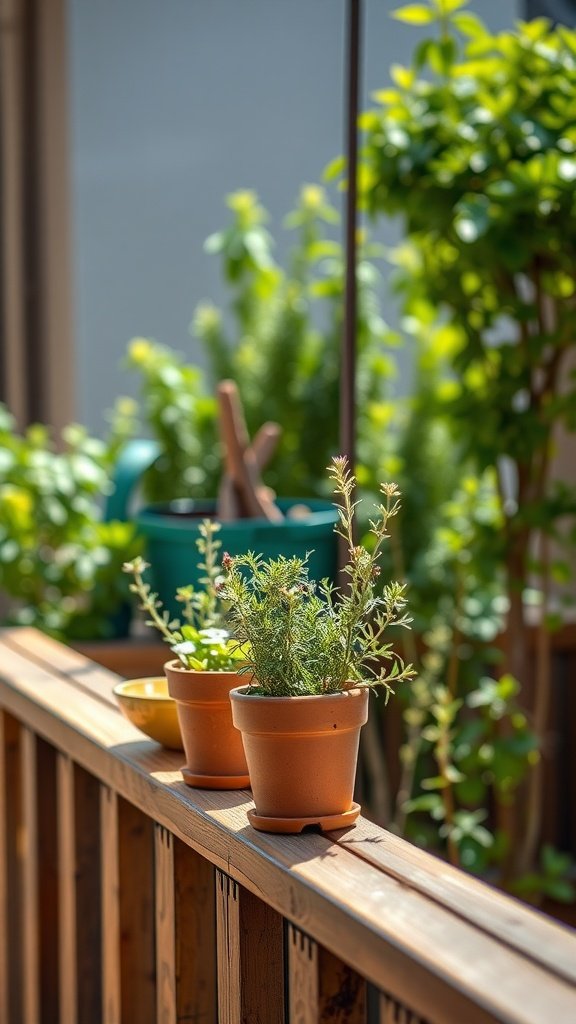
When it comes to herb gardening, using smaller pots can work wonders, especially if space is tight. The image showcases some lovely smaller pots, each filled with vibrant herbs like thyme and oregano. These compact arrangements not only save space but also add a splash of greenery to any area.
Small pots are perfect for balconies, window sills, or even kitchen counters. You can easily manage your herbs and ensure they receive adequate sunlight and care. Plus, they’re easier to move around if you want to change things up a bit.
Growing herbs in these smaller containers means you can mix and match different varieties. Imagine having fresh oregano ready for your pasta dishes or harvesting thyme for aromatic soups right from your own home. It’s simple and rewarding!
Repurpose An Old Shoe Organizer As A Herb Planter.
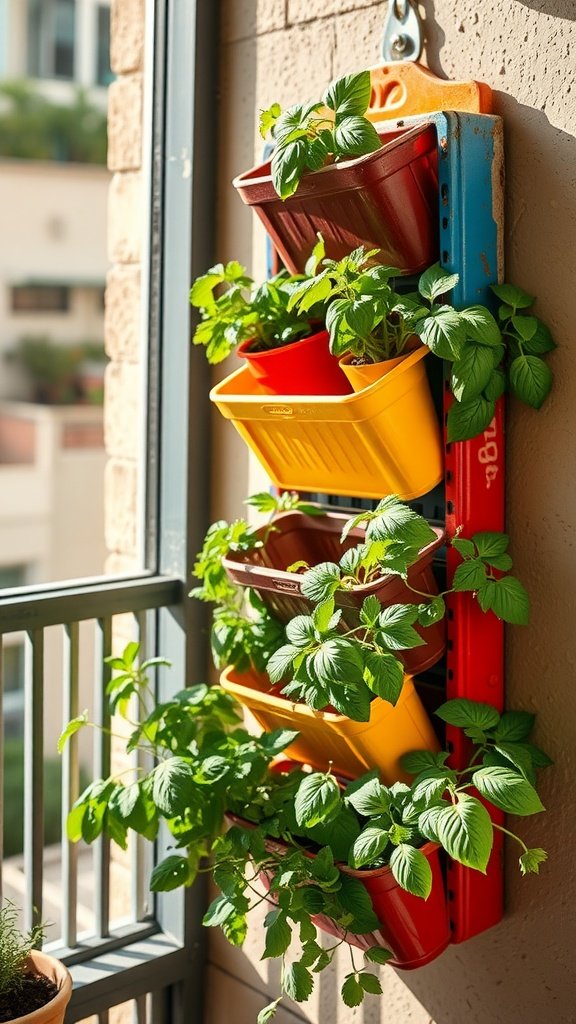
Using an old shoe organizer for herbs is a fun and practical way to spruce up your space. The image shows a vibrant, colorful shoe organizer mounted on a wall, filled with lush green herbs. Each compartment holds a different plant, creating a lively display.
This hack is perfect for small balconies or kitchens where counter space is limited. Just hang it up and fill each pocket with your favorite herbs like basil, mint, or parsley. You can even mix in some flowers for a pop of color!
Maintaining your herb garden is simple. Just ensure that each plant gets enough sunlight and water. The shoe pockets allow for good drainage, and the vertical design saves space. With this setup, you’ll always have fresh herbs at your fingertips.
Plus, it’s a great conversation starter for guests. They’ll be amazed at your creativity in repurposing an everyday item. So, gather your old shoe organizer and start planting; your kitchen will thank you!
Keep Herbs Pruned Regularly To Encourage New Growth.
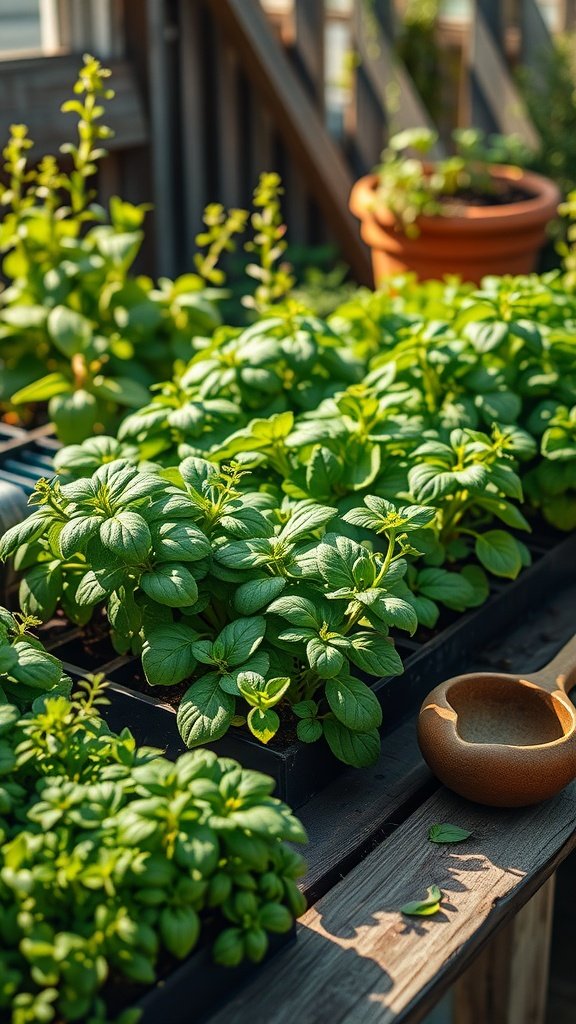
In the picture, you’ll see a vibrant herb garden filled with lush greenery. The containers are overflowing with healthy herbs, just waiting to be snipped. This scene is a perfect reminder of the importance of regular pruning. Keeping herbs pruned not only keeps them looking tidy but also encourages fresh and vigorous growth.
Regular pruning helps to maintain the shape of the plants. It prevents them from becoming leggy and ensures they produce more leaves. With each cut, you stimulate the plant to grow new shoots. If you notice some herbs starting to flower, it’s a good idea to trim those flowers off. Flowering can sometimes lead to a bitter taste, so keeping your herbs focused on leaf production is key.
Using clean, sharp scissors or pruners will make the job easier and help prevent damage to the plant. Prune regularly, and you’ll be rewarded with a plentiful supply of fresh herbs for your kitchen. Whether you’re making a salad, a sauce, or just garnishing a dish, your freshly pruned herbs will add flair and flavor. So grab those scissors and start snipping!
Create A Herb Garden On Your Balcony Using Hanging Baskets.
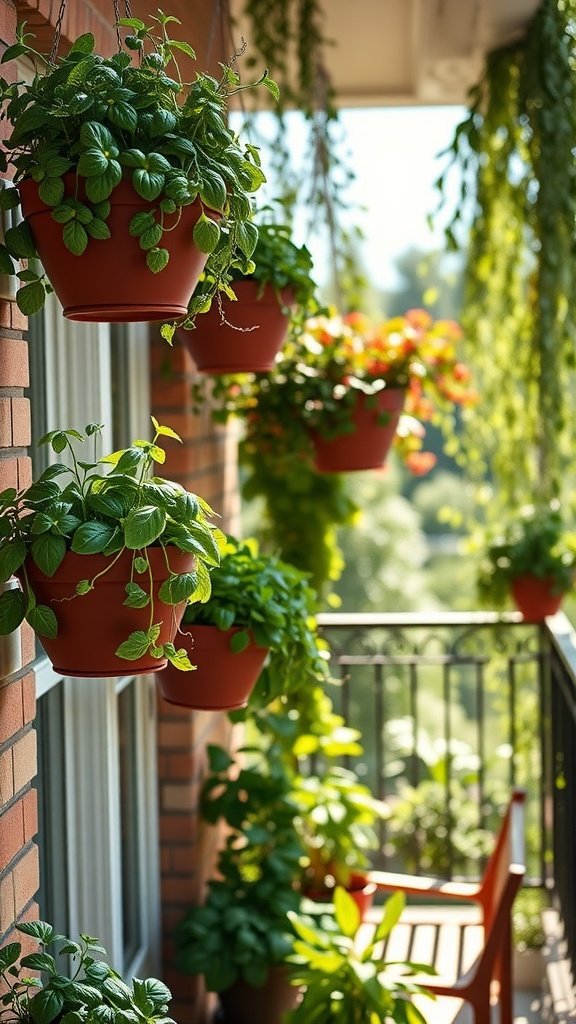
Transforming your balcony into a lush herb garden is simple and fun. Using hanging baskets is a fantastic way to save space while adding greenery. The image shows a beautiful balcony adorned with vibrant hanging pots filled with various herbs. The rich green leaves create a lively contrast against the warm brick wall, giving the space a fresh and inviting feel.
Hanging baskets not only look great, but they also provide flexibility in arranging your plants. You can hang them at different heights to create a dynamic display. This is a great way to maximize sunlight for your herbs, ensuring they receive the necessary light for healthy growth. Imagine having fresh basil, mint, or rosemary just a reach away from your kitchen!
When choosing your herbs, consider what you love to cook with. Herbs like thyme, parsley, and cilantro do really well in containers. Plus, they thrive in hanging baskets, making them perfect for this setup. Make sure to use lightweight potting soil and choose baskets with good drainage to keep your herbs happy.
Use A Humidifier To Maintain Moisture Levels For Sensitive Herbs.

Keeping sensitive herbs happy can be tricky, but a humidifier can make it a lot easier! In the image, you see a stylish humidifier sitting among fresh herbs like basil, mint, and tomatoes. The humidifier releases a gentle mist, helping to create the right environment for those delicate plants.
Herbs like cilantro and basil thrive in humid conditions. When growing these plants indoors, they can often suffer from dryness, especially in the winter months. A humidifier not only adds moisture to the air, but it also keeps the leaves lush and vibrant.
Simply place the humidifier near your herb garden, and adjust it to a suitable setting. This way, you’ll maintain comfortable moisture levels, making your herbs happier and healthier. You’ll likely notice an improvement in their growth and flavor, too!
Make Your Own Herb Drying Rack Using String And Clothespins.
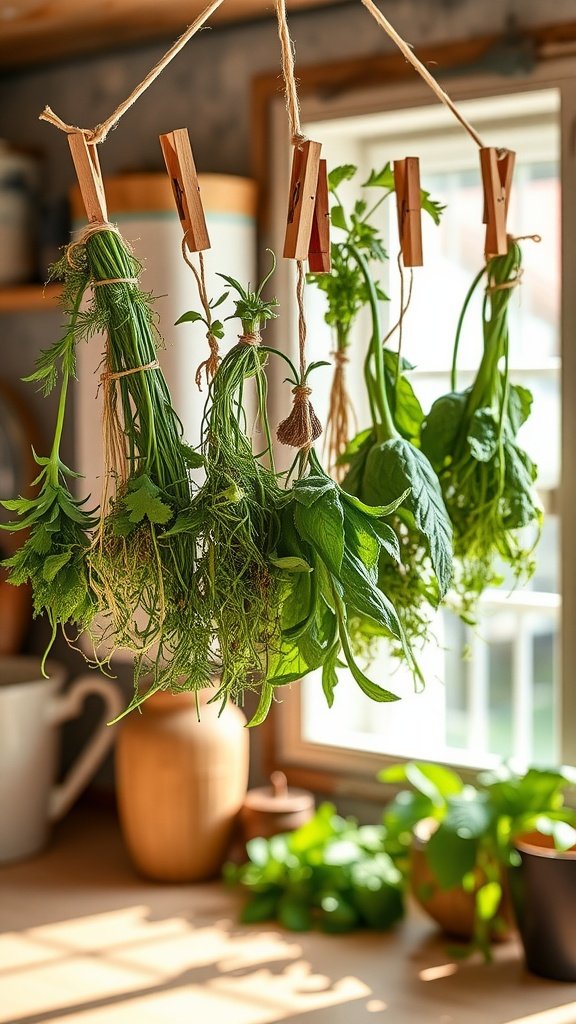
Creating a DIY herb drying rack is easy and fun. The image shows fresh herbs hanging gracefully, secured with clothespins on a string. This simple setup not only looks charming but also makes the most of your herbs after harvesting.
To make your own, gather your favorite herbs, some twine or string, and clothespins. Start by rinsing the herbs and allowing them to dry. Next, tie small bundles of herbs together with the string. Attach these bundles to the string using the clothespins, ensuring they are spaced out for air circulation.
This method is perfect for drying herbs like basil, mint, and parsley. Once dried, you can store them in jars or use them in your favorite recipes. Enjoy the satisfaction of preserving your homegrown bounty!
Grow Herbs In A Water-Based Hydroponic System For Faster Growth.
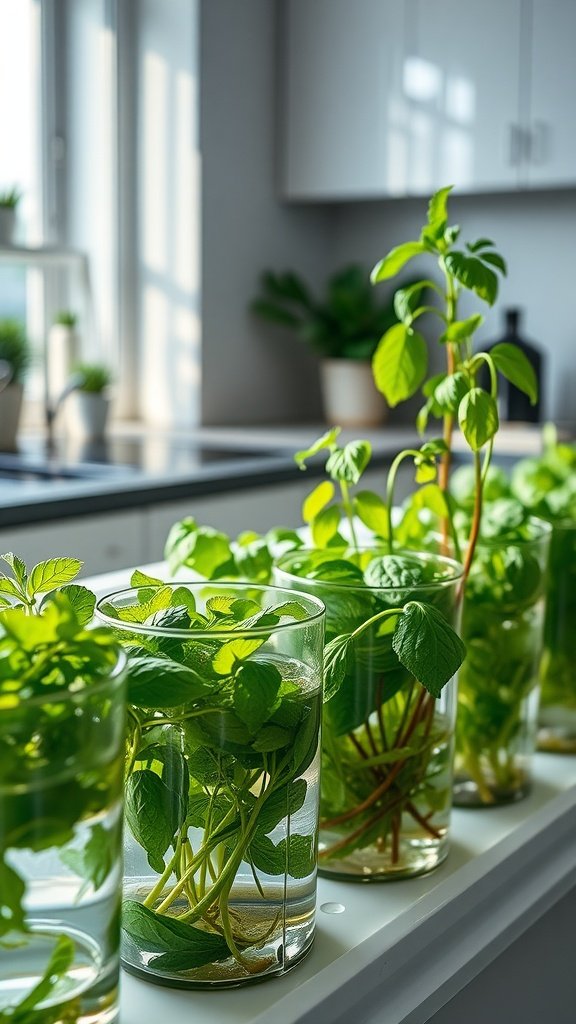
If you’re looking to spice up your herb garden, consider a water-based hydroponic system! This method allows your herbs to thrive in a nutrient-rich water solution, which can lead to quicker growth compared to traditional soil planting.
The image shows several herbs, likely mint or basil, placed in clear glasses filled with water. You can see the vibrant green leaves, indicating they’re healthy and thriving. This setup not only looks great but also makes it easy to monitor the growth of your plants.
Starting a hydroponic system is simple. Just take cuttings from your favorite herbs and place them in water. Make sure to use clean, clear containers so you can observe root development. Change the water regularly to keep it fresh, and soon, you’ll have lush herbs ready for your recipes.
This method is perfect for kitchens, allowing easy access to fresh herbs while adding a touch of greenery to your space. Plus, hydroponically grown herbs tend to be free of soil pests, making your gardening experience a breeze!
